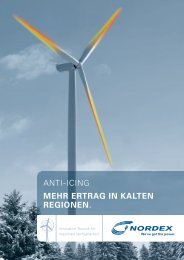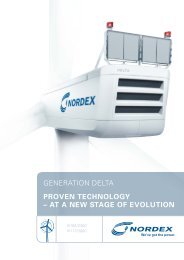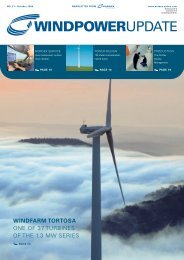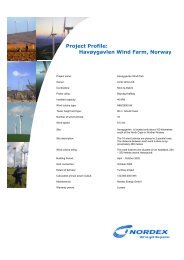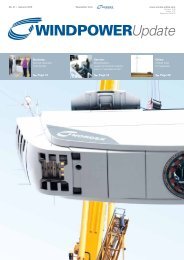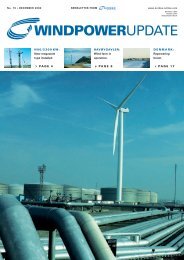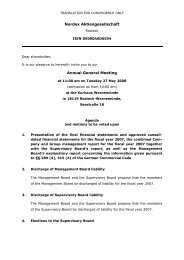OFFERING MEMORANDUM Global Offering of up to ... - Nordex
OFFERING MEMORANDUM Global Offering of up to ... - Nordex
OFFERING MEMORANDUM Global Offering of up to ... - Nordex
Create successful ePaper yourself
Turn your PDF publications into a flip-book with our unique Google optimized e-Paper software.
The following figure illustrates the key components <strong>of</strong> a wind turbine:<br />
The ro<strong>to</strong>r blades<br />
The ro<strong>to</strong>r blades form the mo<strong>to</strong>r <strong>of</strong> the wind turbine. The wind turbine uses the ro<strong>to</strong>r blades <strong>to</strong> collect<br />
kinetic energy from the wind and <strong>to</strong> convert this energy in<strong>to</strong> a rotation <strong>of</strong> the ro<strong>to</strong>r. The area swept by<br />
the ro<strong>to</strong>r blades (length <strong>of</strong> the ro<strong>to</strong>r blade *p), the aerodynamic pr<strong>of</strong>ile <strong>of</strong> the ro<strong>to</strong>r blades and the<br />
rotational speed <strong>of</strong> the ro<strong>to</strong>r are the key fac<strong>to</strong>rs determining the capacity <strong>of</strong> the wind turbine. In<br />
turbines with stall-regulation, the ro<strong>to</strong>r blades are fixed <strong>to</strong> the hub, whereas in turbines with pitchregulation,<br />
they are attached so that they can rotate along their longitudinal axis. Wind turbines are<br />
manufactured <strong>to</strong>day almost exclusively with three ro<strong>to</strong>r blades.<br />
Energy conversion via the drive train and genera<strong>to</strong>r<br />
The ro<strong>to</strong>r blades are attached <strong>to</strong> the hub, which in turn is connected <strong>to</strong> the ro<strong>to</strong>r shaft. The ro<strong>to</strong>r shaft<br />
transfers the revolutions <strong>of</strong> the ro<strong>to</strong>r <strong>to</strong> a gear, which itself is linked <strong>to</strong> the genera<strong>to</strong>r <strong>of</strong> the wind<br />
turbine by way <strong>of</strong> a co<strong>up</strong>ling. The unit comprising the ro<strong>to</strong>r shaft, gear and genera<strong>to</strong>r is termed the<br />
drive train <strong>of</strong> the wind turbine.<br />
The genera<strong>to</strong>r at the end <strong>of</strong> the drive train converts the revolutions <strong>of</strong> the ro<strong>to</strong>r blades in<strong>to</strong> electrical<br />
power. The wind turbine’s gear serves <strong>to</strong> increase the rotational speed <strong>of</strong> the ro<strong>to</strong>r <strong>to</strong> match the speed<br />
<strong>of</strong> the genera<strong>to</strong>r. Depending on the technical design, the genera<strong>to</strong>r can be operated either at a<br />
constant rotational speed (stall regulation) or at a variable speed.<br />
Power regulation and limitation (stall and pitch regulation)<br />
Depending on the technique employed <strong>to</strong> regulate and limit their capacity, wind turbines are generally<br />
classified as stall-regulated or pitch-regulated.<br />
Stall regulation<br />
In a wind turbine with stall regulation, power regulation is achieved by causing the air flow <strong>to</strong> stall by<br />
means <strong>of</strong> the aerodynamic pr<strong>of</strong>ile <strong>of</strong> the blade when a certain wind speed is exceeded, preventing the<br />
wind turbine from capturing an increasing amount <strong>of</strong> energy. In order <strong>to</strong> increase the energy yield in<br />
lower power classes, it is possible <strong>to</strong> design the genera<strong>to</strong>r in such a way that it can operate two<br />
different nominal rotational speeds in order <strong>to</strong> generate power more efficiently at various wind speeds.<br />
Stall-regulated wind turbines are braked through the front 1.5m <strong>to</strong> 3m <strong>of</strong> the relevant ro<strong>to</strong>r blade<br />
which can be rotated around its longitudinal axis. This is achieved through a hydraulic mechanism<br />
45




